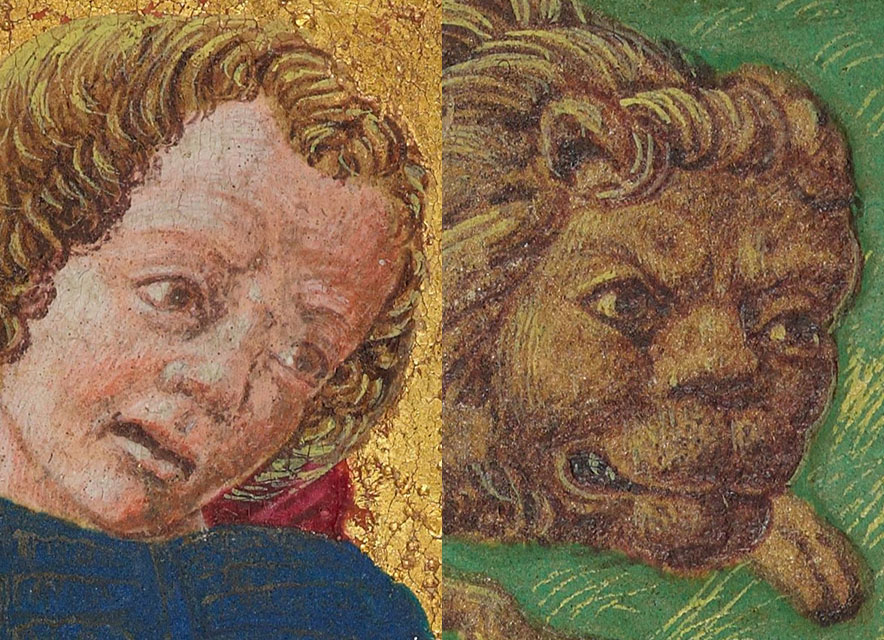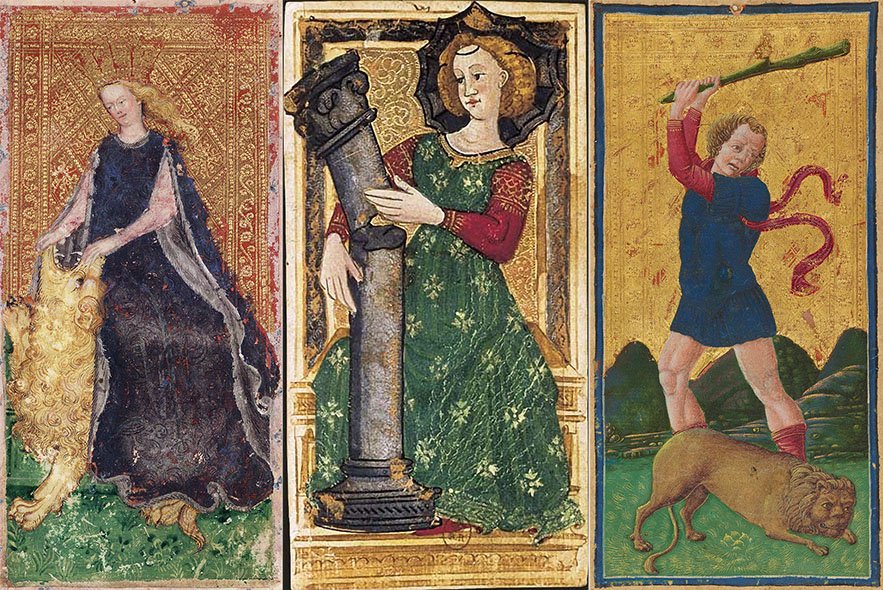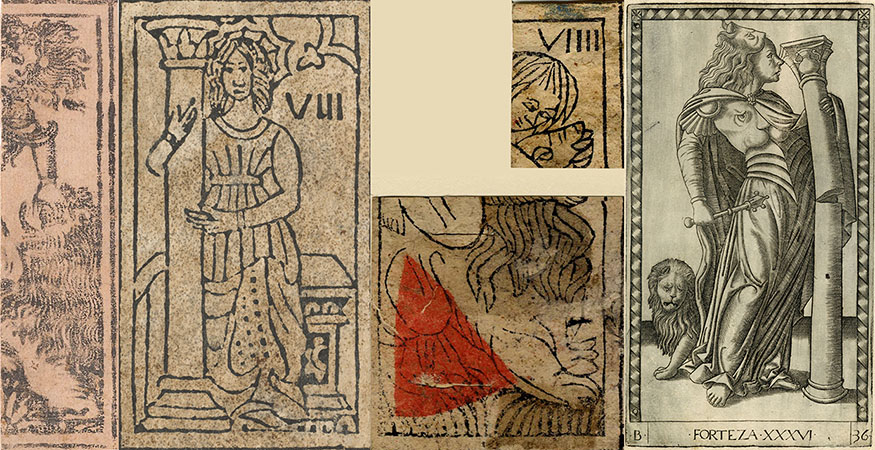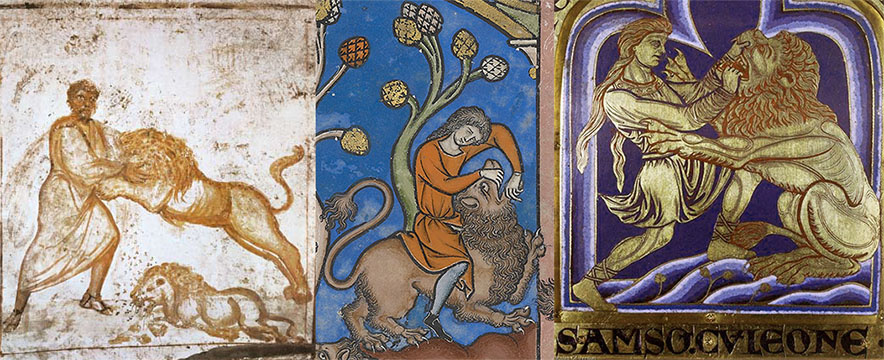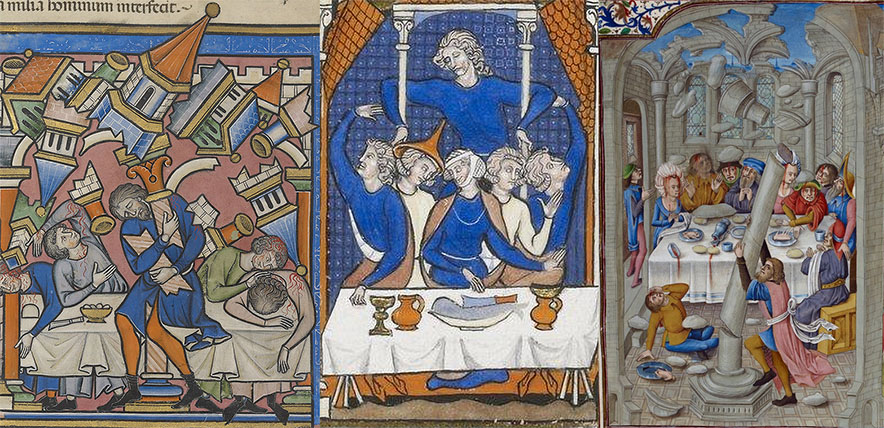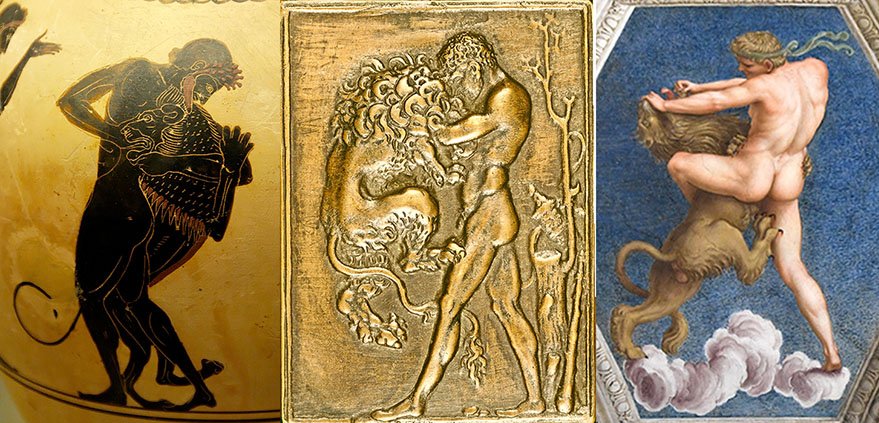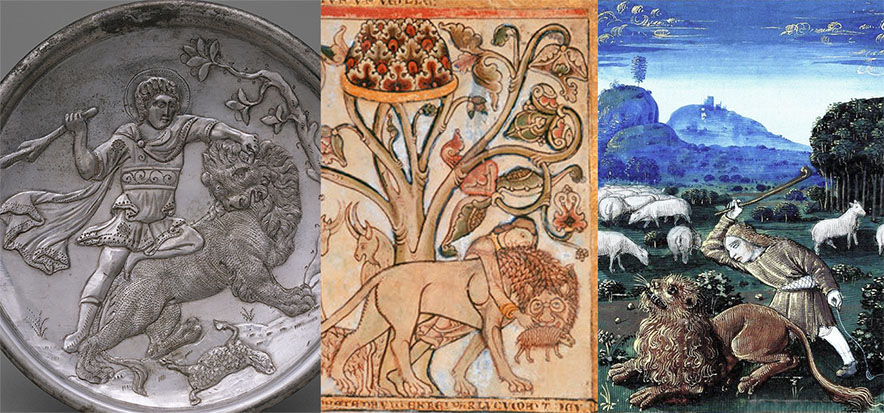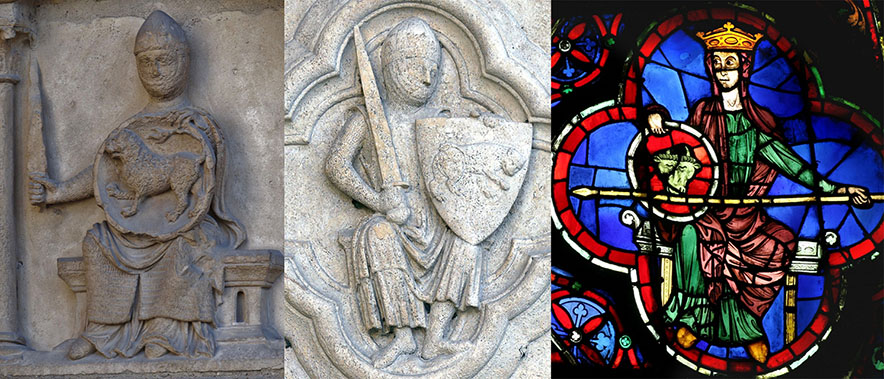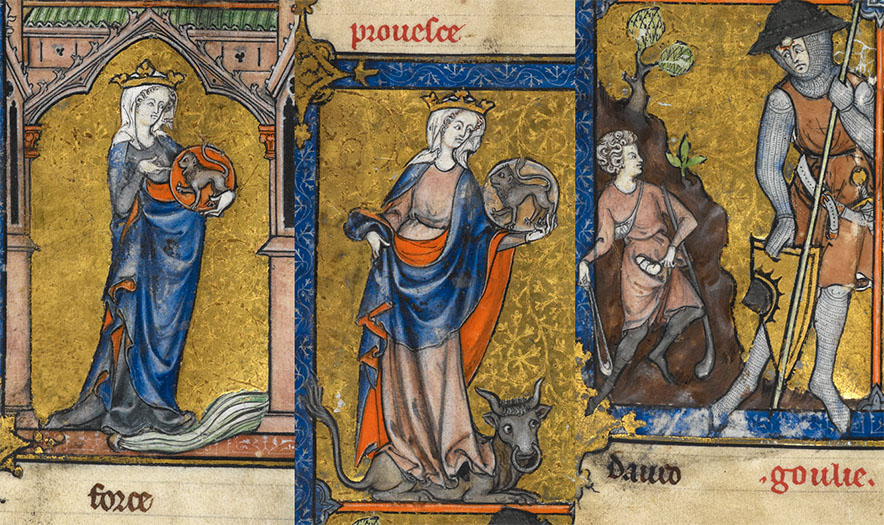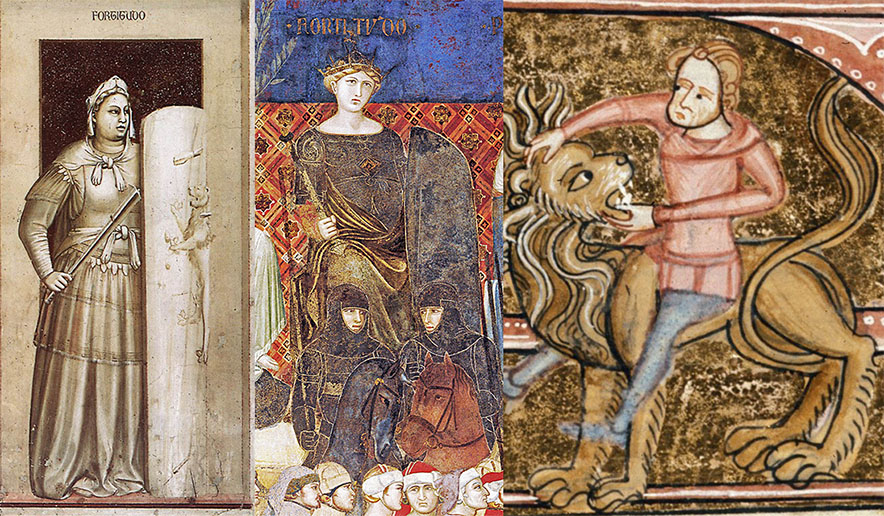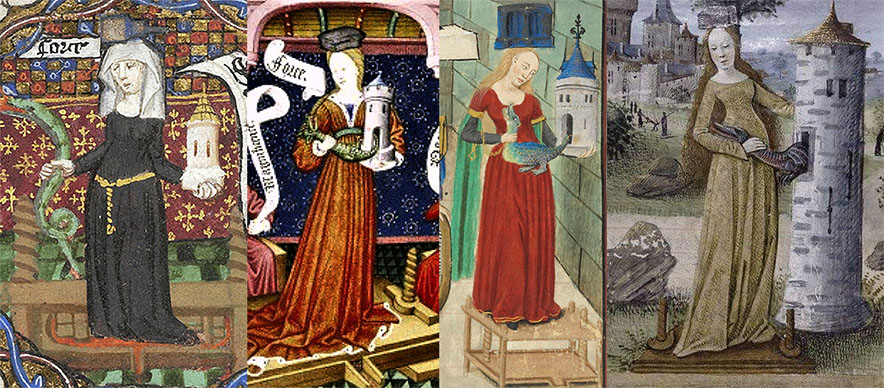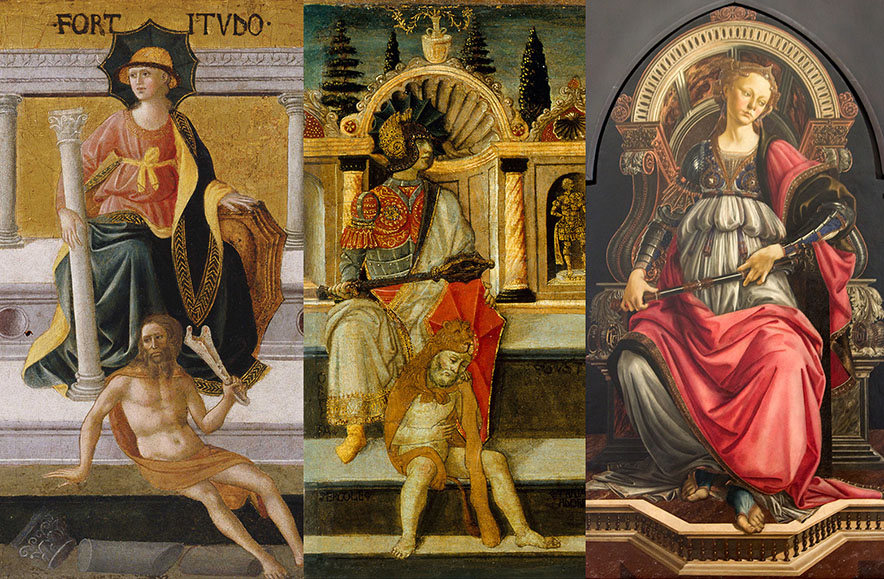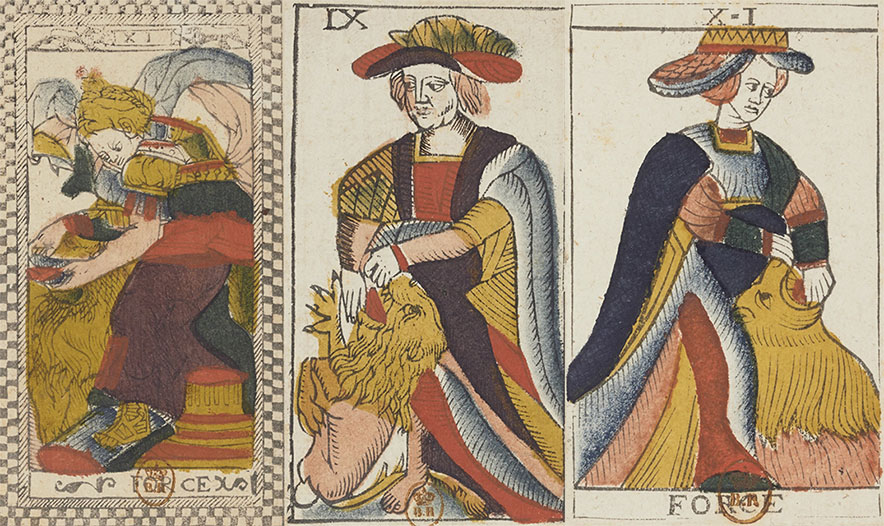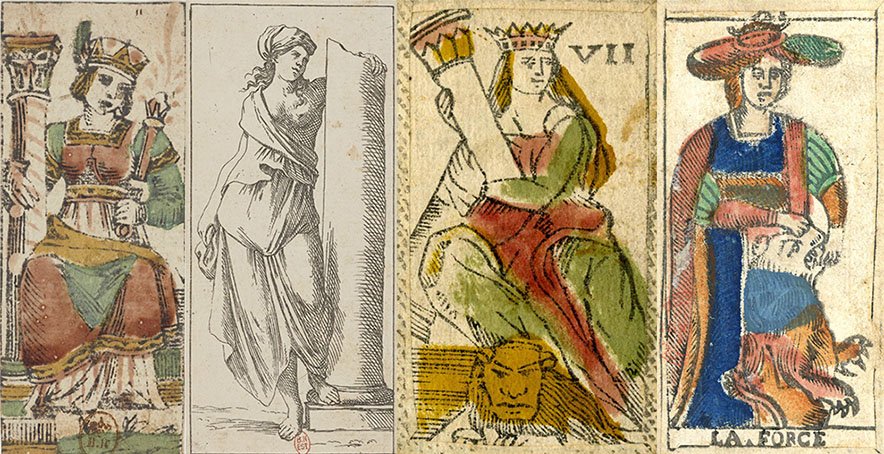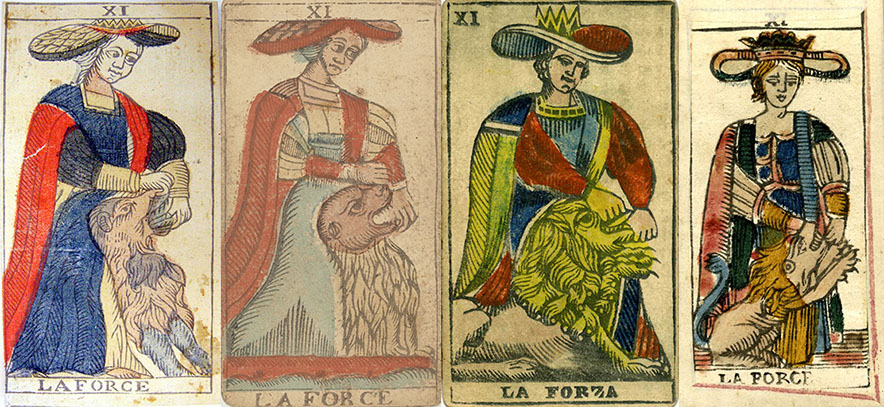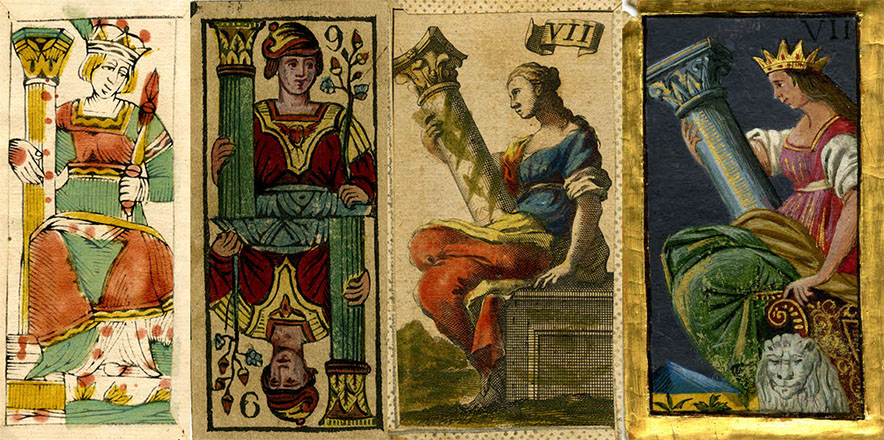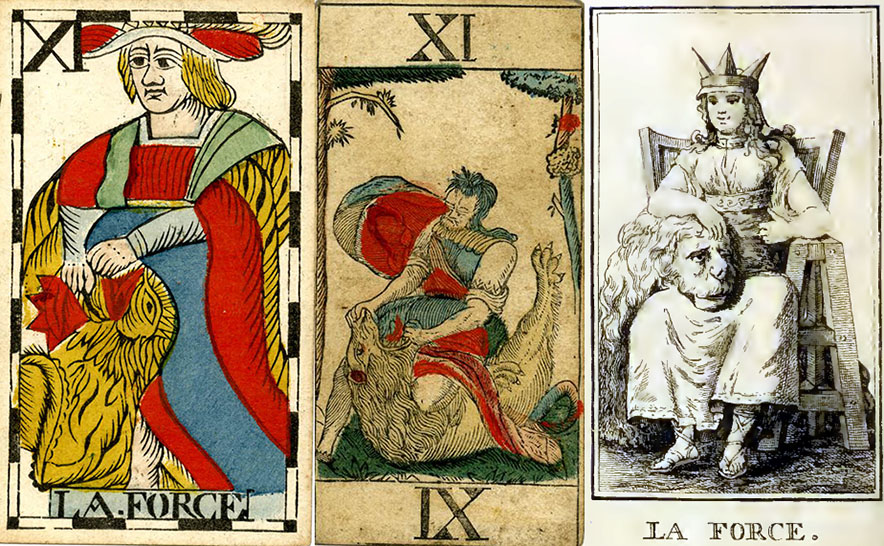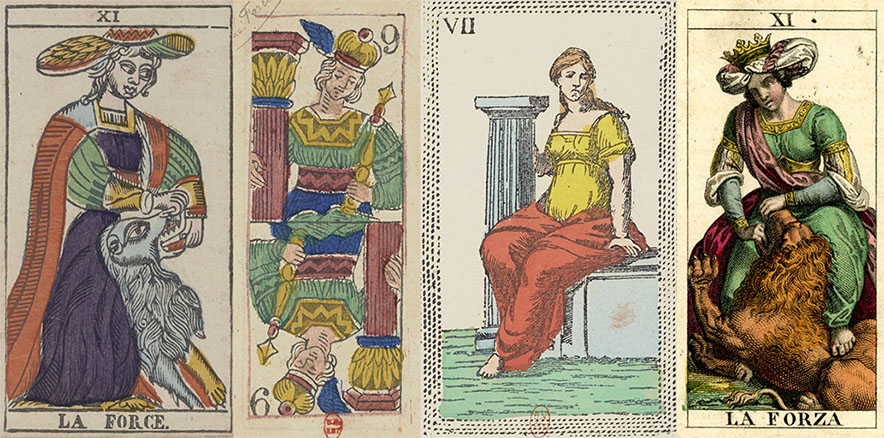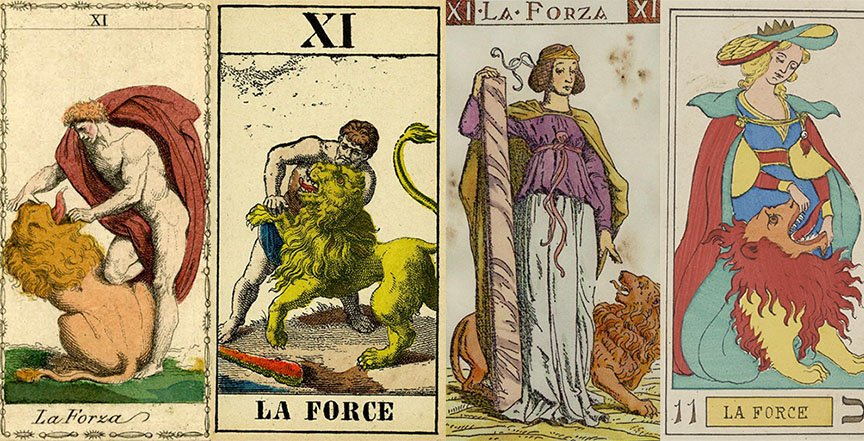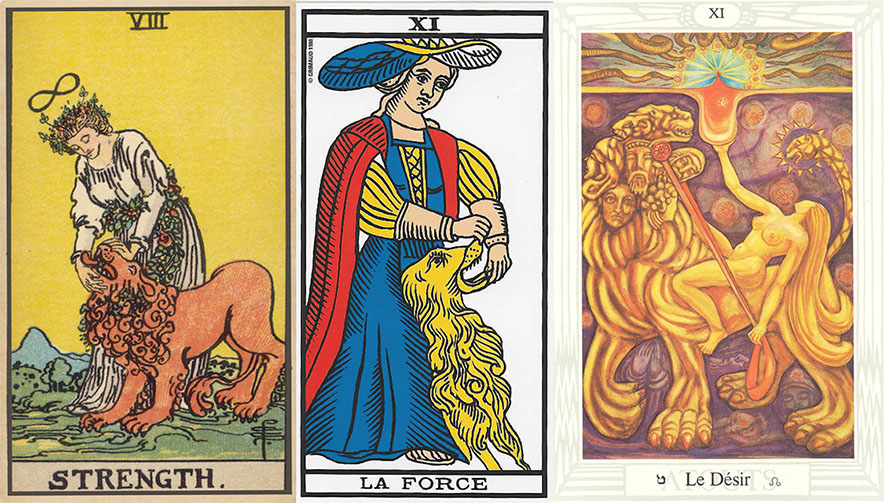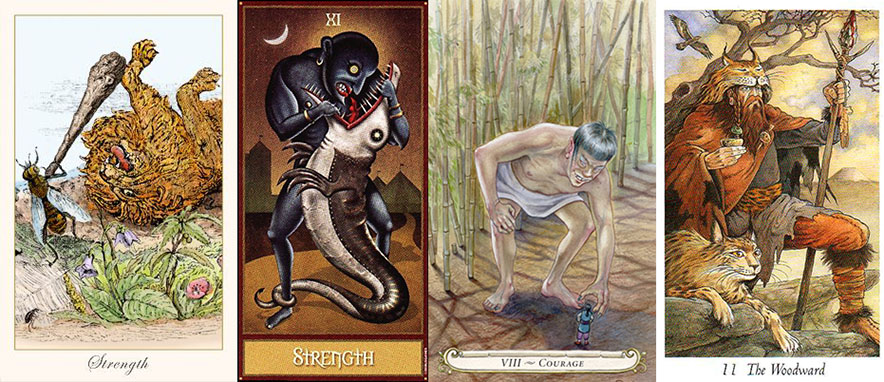THE TAROT WHEEL
LA FORTEZZA - FORCE
We start our journey through time in company of the Force card, with a double close-up of the Visconti Sforza card. This close-up is to show how important it is to look at all the details of a card. We come back to this issue here below, where the whole card is visible. Force in the Tarot stands for moral force and courage, and has nothing to do with physical force. The card is also called Fortitude or Strength. Three 15th Century hand-painted cards survived time, they are presented here below.
Three images of Strength, all three very different. The first image is from the Visconti di Modrone deck, ordered by the Milanese Duke Filippo Maria Visconti and realized in 1441 on the occasion of the wedding between his daughter Bianca Maria Visconti and the condottiero (Captitano di Ventura in Italian) Francesco Sforza. On the card we see the virtue of Fortitude opening a lion's mouth with here bare hands. The image refers to the Bible, Judges 14:5-6, where Samson goes to Timnath and slays a lion with his bare hands. The second card is from the so-called Charles VI Trionfi deck, probably commissioned by the Ferrarese Duke Ercole I of Este, probably somewhere in between 1460 and 1475. On this card, we see the virtue of Fortitude breaking a pillar in two. She is wearing a large hat that resembles a spiderweb, in that time often used for the representation of the virtues, This Trionfi card also refers to a bible text concerning Samson, this time Judges 16:26-30. In this text, Samson committed suicide in destroying the Temple of Dagon, while killing many Philistines by this act. Today, we would call this a terrorist act, in the Bible it is an act of courage inspired by the Holy Spirit. The third card is from the Visconti Sforza deck. This card belongs to a group of cards, added probably in between 1475 and 1490 to the existing deck, to complete the structure. We see on the card a man holding a club in his both hands and in the foreground a small lion. Most people associate this card with a Greek myth, the first of the 12 works of Hercules, where he is killing the Nemean lion. Others prefer a biblical reference and refer to 1 Samuel 17:34-35, where the young David kills a lion to protect the sheep of his father. However, both references are probably not correct for this card. If we look in detail to the image (see the double image presented at the top of this page), we see that both the man and the lion are looking to our right side, as if a big danger is approaching from here. Man and lion are ready to affront together this danger.
The printed decks in the late 15th Century follow the same symbolism:
Here above we see some fragments of uncut sheets dating from the end of the 15th Century, as well as a 1465 print of the so-called Tarot of Mantegna. The first fragment is part of the Cary Sheet, probably from Milanese origin. We can just distinguish here the virtue of Fortitude, grasping the mouth of a lion, like on the card of the Visconti di Modrone deck. Next to this fragment, we see a complete virtue of Fortitude card from the Rosenwald sheet. She is holding a pillar in her hands, referring to Samson and the destruction of the temple of Dagon. Here also, the virtue Fortitude is marked with a headgear in the form of a spiderweb. The third card consists of two incomplete fragments of the virtue of Fortitude, coming from the Budapest sheets. However, we can easily distinguish, like on the Cary sheet, a human figure sitting on a lion and holding its mouth with her hands. The figure is probably a naked man, referring in this way to the myth of Hercules. The Tarot of Mantegna is neither a Tarot deck nor made by Mantegna. It is a series of fifty prints made in 1465 by an unknown master, with a structure loosely related to the Tarot trumps. Many of the Tarot trumps are present in this series, and so is the virtue of Fortitude. In this particularly print, the artist combines both Samson stories to present the lion and the broken pillar together in one image.
In the above images (hand painted and printed), we have seen that that card makers used different references to present the virtue of Fortitude. Only the Visconti Sforza card representing the virtue of Fortitude does not have a clear reference to an existing text. Let us now have a look how Strength was presented in Medieval and Renaissance Art, first presenting Biblical and Mythological scenes that might have been at the base of the earliest Trionfi imagery and next presenting how the virtue of Fortitude pas pictured elsewhere in Medieval and Renaissance art. Let us start with the first group. We begin with Samson and the lion, the principal source of inspiration for the Visconti di Modrone card.
Biblical scenes were a very popular source of inspiration for Medieval art, and Samson is not an exception. Here above we see from left to right first a 5th Century Fresco from the Catacombs of the Via Latina in Rome, depicting Samson struggling with a lion. The second image is from a picture Bible, realized between 1244 and 1254 in Paris. The third image is from an altarpiece, realized in 1180 by the Flemish artist Nicolas de Verdun, in the St. Leopold’s Chapel of the Klosterneuburg Abbey in Austria. All three pieces of art are made in a religious context, the reason why we are sure the images are referring to a Bible text, and not to the myth of Hercules.
The second Biblical scene that inspired the representation of the Virtue of Fortitude, and the card of Fortitude in the Charles VI deck, was the suicide of Samson. Here above three images coming from medieval manuscripts. The first image is from the same Paris made picture Bible as presented in the previous series of images. The second image is from a Psalter made for king Louis IX, better known as Saint Louis, dated to the last years of his reign, somewhere in between 1254 and 1270. The third image is from a 15th Century manuscript dealing with the Chronicles of Baudouin d'Avesnes. All three images show a very similar scene of Samson destroying a building on the head of people gathered around a table. The first two images are typical Medieval drawings, but on the third image are appearing very clear Renaissance characteristics, like the use of perspective.
The next three images represent the struggle between Hercules and the Nemean lion. From left to right, we see a first a Greek vase painting realized between 520 and 500 BC. On the second image, we see an Italian bronze bas-relief made around 1488-1489. On the third image, we see a fresco made by the Italian painter and architect Baldassare Peruzzi, who realize this painting around 1510-1511 in the Villa Farnesina in Rome, a building designed and built by himself. On all three images, we see a naked Hercules wrestling with his bare hands with the Nemean lion, a representation that is very different from Fortitude on the Visconti Sforza deck.
The next three images represent David protecting the sheep of his father. The first image is from a Byzantine plate made around 629-630. We see here David going to hit the lion with a club with the lamb he wants to save under the lion. The second image is a detail from Psalter of Henri de Blois, realized somewhere between 1121 and 1161 and conserved in the Winchester Priory of St Swithun. Henti de Blois, grand-son of William the Conqueror, king of England in the 11th Century, was the bishop of Winchester from 1129 to 1171. Here we see the young David saving a lamb from the mouth of the lion. The third image is from a Book of Hours realized around 1490 for Louis of Orleans, who would become in 1498 King Louis XII of France. On this image, we see again David hitting a lion with a club. In the background, the herd of sheep that he is protecting. On the Visconti Sforza card, the young man is also using a club, but this time not against the lion but to combat together with the lion a danger. Apart from the club, there is little resemblance with the VS-card, where no sheep are visible. As a conclusion, we can safely eliminate David for being the source of inspiration for this card.
Now we have seen the different possible sources for the representation of the virtue of Fortitude, let's have a look at the representation of Fortitude itself in Medieval and Renaissance art. We start with the oldest representations, realized in the beginning of the 13th Century
We find the oldest representations of the virtue of Fortitude in French cathedrals. The first image here above is a bas-relief from the Cathedral de Notre Dame in Paris, realized around 1220. We see here Fortitude as a human figure in full armor, with a sword in one hand and a shield depicting a lion in the other. The second image is very similar and even older. It dates to the year 1200 and is a bas-relief from the cathedral of Amiens. The third image is slightly younger than the two other images. The image is again from the cathedral de Notre Dame in Paris, now as part of a huge rose window in stained-glass. Fortitude is presented here in the same way, but with the head of a Bull on her shield. On this image, Fortitude is clearly depicted as a woman.
Later in the 13th Century, this representation of the virtue of Fortitude continued to be a woman carrying a shield, illustrated with an animal, in the vast majority a lion, symbolizing strength. All three images here above are from the same manuscript, a copy of a text called 'Somme le Roi', written between 1270 and 1285 by the Dominican friar Laurent for the children of King Philippe III. This particular copy has been realized in 1295 by a certain maître de Papeleu. 'Somme le Roi' is a treatise about the virtues and vices. The first image represented here is the virtue of Fortitude as a queen holding a round shield or medallion in her hands, with an illustration on this device, depicting a lion. In other copies of this manuscript, she is represented in exactly the same way. The following two images are from the next page of the same document. These two images represent some prowess of Fortitude (expressions of courage). On the image in the middle, we see the same queen (with a medallion in her hands) standing on a bull, also a symbol of strength and courage. The last image is a biblical scene, presenting the young sheep herder David, defeating the giant and experienced warrior Goliath.
In the 14th Century, the representation of the virtue of Fortitude started to evolve. The first image is a detail of a fresco that has been painted in 1306 by Ambrogiotto di Bondone (commonly called Giotto) in the Scrovegni chapel in Padua. Here the virtue of Fortitude is still represented as an armed lady, this time with a giant shield, that is again decorated with a lion. Even her headgear is in the form of the head of a lion. The next image is a detail from the fresco representing the Allegory of Good Governance, painted in 1338 by Ambrosio Lorenzetti. Here Fortitude is still depicted as an armed lady, but impossible to recognize what is painted on her shield. The third image is from an English manuscript realized in between 1360 and 1375 by James le Palmer and titled Omne Bonum (Ebrietas-Humanus). Here, the virtue of Fortitude is depicted as a man fighting with a lion.
In the 15th Century, the representation of the virtue of Fortitude developed further. The prevailing representation in French manuscripts is shown here above. From left to right, we have first a representation of the virtue of Fortitude from a 1430-1435 Paris Book of hours. The second image is from the Book of the three virtues, realized around 1450 by Christina de Pizan. The third image is taken from a 1453 book about the ethics of Aristotle, made in Rouen. The last image has been made by Jean Colombe somewhere in the second half of the 15th Century. On all images we see the virtue Fortitude standing on a wine press, with an anvil on her head, pulling a dragon from a tower. In Italy however, the virtue of Fortitude was depicted differently.
The Italian allegories of Fortitude are represented by three painters of the Florentine school. The first image on the left has been painted in 1450 by Francesco Pesellino. Here the virtue of Fortitude is depicted as a lady with in one hand a pillar and in the other a shield. On her head, she has a headgear in the form of a spiderweb, indicating that she represents a virtue. Under her feet an almost naked man representing the vice of cowardice. The second image has been painted in 1465 by Anton Francesco della Scheggia. Here the virtue of Fortitude has a protective armor and helmet and is carrying a club in her hand. The helmet has also a decoration in the form of a spiderweb. Under her feet, an almost naked vice of cowardice, with the hide from a lion on his back. The third painting is realized around 1471 by Sandro Botticelli. Here again the virtue of Fortitude has a protective armor on her upper body and a club in her hand. So on these paintings we see the same three elements, as we have seen in the hand painted Trionfi cards: a pillar, a lion and a club.
After this extended art section, let us see how the virtue of Fortitude was depicted on later Tarot cards. Let us start in 17th Century France.
In France the card makers adopted right from the beginning, for the virtue of Fortitude, the same image as used on the Visconti di Modrone, a lady opening with her bare hands the mouth of a lion. All three decks are from the 17th Century and all three decks have been produced in Paris. In view of the identical color scheme on the different decks, it is very probable they have been made in the same printing workshop (even the verso of the cards shows the same pattern on all three decks). From left to right, we have the virtue of Fortitude of the anonymous Tarot of Paris, the Tarot of Jaques Vievil and the Tarot of Jean Noblet, the oldest known TdM deck. Except for the difference in style, there is no difference between these three cards.
The Italian Tarot related decks originating from the 17th Century showed a different symbolism, more in line with the Charles VI Fortitude card. From left to right, we have the virtue of Fortitude from an early 17th Century Bolognese Tarocchino deck, a 1664-1668 Tarocchino card made by Giuseppe Mitelli in Bologna, a 17th Century Florentine Minchate card and a late 17th Century Bolognese Tarocco card, based on the TdM model. On the first (and standard) Tarocchino card, we see the virtue of Fortitude with a pillar and a club. On the card made by Mitelli the virtue of Fortitude is leaning against a broken pillar. Remark, that the card is in black and white, Mitelli left it up to its clients to color the deck. On the Minchiate card, the virtue of Fortitude has a pillar in her hands and a lion at her feet. The Tarocco card however, does not use the pillar as a symbol of strength, and is very similar to the TdM of Jean Noblet presented here above. The only difference is that on the card here above, the lion raises its front legs, where we don't see them on the Noblet card. We conclude that all cards from Italian origin use the pillar as the main symbol for the virtue of Fortitude, and we remark that the cards don't show a title. Only the Bolognese Tarocco card, that has a French origin, uses the lion as her main symbol and has the name of the card written in the bottom.
The TdM tradition did not change in the 18th Century, and this style of cards is made in several countries. From left to right, we have a TdM type II Fortitude card made by Rochus Schaer in 1750 in Mümlisville in Switzerland, a Besançon style Fortitude card, published in 1746 by François Laudier (card maker) and Pierre Isnard (engraver) in Strasbourg, a Piemontese style Fortitude card, realized in the second half of the 18th Century by Rossi in Torino and a Tarocco card, printed in 1790 by Angelo Valla in Trieste. On the TdM card, and on the Besançon card, the fore legs of the lion are posed on the ground. On the Piemontese card, the lion raises its left front leg (like on the Visconti di Modrone card, where the card is mirrored, and where the lion raises its right front leg). On the Tarocco card, the lion raises both its front legs. The clothing of the virtue of Fortitude is similar on all cards and on all the images she opens the mouth of the lion with her bare hands, like on the Visconti di Modrone card.
In Italy, in the 18th Century, we have three main Tarot related types of decks. The oldest one, that is respecting the best the 15th Century imagery, is the Tarocchino developed in Bologna. We can trace the Tarocchino decks back to the end of the 15th Century. Next comes the Florentine Minchate, that has its origins probably in the 17th Century. The third kind of imagery is the Tarocco deck, that is based on the TdM model and presented here above. During most of the 18th Century, the Tarocco decks kept their French Titles. The four cards here above are from Tarocchino and Minchiate decks. The first deck on the left is attributed to Antonio de Maria. It is a typical example of the mid 18th Century Tarocchino decks, and the Fortitude card is virtually identical to its 17th Century ancestors. Around 1770 the Tarocchino decks became double-headed and received the number written on the card, both changes to facilitate game playing. The second anonymous card is a typical example of the Tarocchino cards at the end of the 18th Century. The third card is representative for the Florentine Minchiate decks in the second half of the 18th Century. Thanks to better printing techniques, the image becomes more elaborate with respect to the 17th Century cards, The virtue of Fortitude is now sitting on some sort of furniture but the lion disappeared from her feet. The last example is again a Florentine Minchiate card from the end of the 18th Century, still a printed card, but this time hand-colored. On the bottom of the card, we see reappearing the image of a lion. On both Minchate cards, we look at the virtue of Fortitude in profile, instead of from the front. From these cards, we can confirm that the pillar of Samson is the prevailing symbol for Fortitude in the Tarot related imagery from Italian origin.
However, not all Tarot cards in the 18th Century conformed exactly to these three models (TdM, Tarocchino and Minchiate). From left to tight we have first a 1775 Fortitude card made by Vandeborre in Brussels, based on the 15th Century Vievil model and mirrored with respect to the TdM (but identical with respect to the Visconti di Modrone card). The second card is from a South German Tarot deck made in 1797 by Franz Jacob Leipert in Stift Kempten. Here we see a real wrestling match, with the lion laying on his back. The suit cards of this deck are all double-headed. The third image is from the second tome of a series of four books, written by Etteilla, printed in 1788 and titled "Manière de se récréer avec le jeu des cartes nommées Tarots". Here we see the virtue of Fortitude as a queen sitting on a chair with a lion on her right side. The lion puts his head on her legs (like my dog is doing all the time when he wants something), an attitude we did not see on previous images. Etteilla redesigned the Tarot completely, and this card is numbered 11 in his deck. This is the same number as on the TdM decks, but this is a complete by chance. In fact, Etteilla numbered the virtues from 9 to 12, regrouping them together like on the Tarocchino decks. With this image, we enter the age of the occultist Tarots. We remark that all these three cards use a lion as symbol for the virtue of Fortitude.
In the 19th Century, most card makers continued to produce the traditional imagery. From left to right, we have first a typical TdM card, belonging to a deck made in 1860 by the Swiss card maker Gassmann in Genève. The second card is an anonymous Tarocchino card published around 1850 in Bologna. Remark that on this card the virtue of Fortitude has again a club (scepter) in her left hand, as in the oldest Tarocchino decks. The third card is a traditional Minchiate card, realized between 1860 and 1890 by Baragioli in Florence. The only difference with the older Minchiate cards is that she is not holding the pillar in her hands, she is just touching it. The last card is a Tarocco card designed by Carlo Dellarocca and printed in 1835 by the German printer Gumppenberg in Milano. While strictly respecting the TdM imagery, the design of the card is much more elaborate, something that became possible, thanks to modernized printing techniques of Gumppenberg.
Like in the 18th Century, some 19th Century card makers used a less traditional approach, although they conserved the known symbols for the virtue of Fortitude, a lion, a pillar or a club. The leftmost image is from the Tarot of Lombardy, printed in 1815 on the Milanese Gumppenberg printing press. Like on the Visconti Sforza deck, we see here a man instead of a woman. The imagery is clearly based on the myth of Hercules and the Nemean lion. Also on the next card, that belongs to the 1831 Swiss 1JJ Tarot, the card maker is clearly inspired by the same myth. On the ground we see a club he might have used. The third card is from the so-called Tarot of the Master deck. It was published for the first time in 1893 by Giovanni Vachetta in Turin in black and white. Later card makers that reproduced this deck added their own color scheme. On the card we see the virtue of Fortitude with both a pillar and a lion. The lion is at her side as if it was her pet animal. On the last card, we go back to the TdM tradition, but modified by occultists. The card here shown in published in 1889 by the Swiss occultist Oswald Wirth who lived and worked in Paris. He kept the TdM card almost unchanged, but he added the Hebrew letter 'Kaf', attributed by Eliphas Levi to the virtue of Fortitude, next to the title of the card. We remark that all cards are numbered 11, like on the TdM decks. In fact, all 78 card Tarot and Tarocco decks are using actually the standardized TdM numbering system.
In the 20th Century, the Tarot jumps to the Anglo-Saxon world, and this will change it forever. We have in this century three extremely influential decks. The first one is the 1909 Raider-Waite-Smith deck, abbreviated to RWS. This deck, drawn by Pamela Colman Smith under the guidance of Arthur E. Waite, popularizes card reading thanks to its efficient imagery on all the 78 cards. Up until today, an estimated 90% of the Tarot decks that are produced, use the RWS deck as a base for their own imagery. The second very influential deck is the Ancient Tarot de Marseille, published in 1930 by Paul Marteau under the Grimaud label. This deck, no matter how ugly the colors are with respect to the original TdM decks, helped to reduce drastically the influence of the Etteilla based Tarot decks and of the extremely popular Oracle decks, to put the Tarot of Marseille back in the center of interest. The third deck is called the Book of Thoth. It has been designed in the forties by Frida Harris under the guidance of Aleiter Crowley, but it has only been published in 1969, long after the death of its authors. The imagery of this deck is far from traditional, and this influenced at a great extent all later Tarot decks. On all three decks, the lion is the main symbol of Strength.
The detailed drawings on all cards of the RWS deck and the exuberant drawings of the Crowley Tarot open up the way for a whole new approach to Tarot. Talented card makers use this freedom to create decks around all sort of themes. Here above some examples of Tarot decks created in the 21st Century. The first card on the left is from the 2006 Fantastic Menagerie Tarot, created by Karen Mahony and Alex Ukolov. The second card is from the Deviant Moon Tarot, probably one of the most popular Tarot decks in the early 21st Century, published in 2008 by Patrick Valenza. The third card is from the Fairy Tale Tarot, created in 2009 by Lisa Hunt. She preferred to call the card Courage. The last card is from the very much praised Wildwood Tarot, imagined in 2010 by Mark Ryan in collaboration with John Matthews and illustrated by Will Worthington, who made also the illustrations for the Druidcraft Tarot. Mark Ryan calls the card Woodward, that stands for warden of the wood. The different artists give all a very different and personal interpretation of the concept of (moral) strength or courage, that has nothing to do with the traditional symbolism.
With these four cards, we come at the end of our journey through time, accompanied by the virtue of Fortitude. It has been a long journey, that allowed us to distinguish between the dominating strength symbols in Italy and France. This length of this journey is emphasizing the importance of this card in the Tarot.
